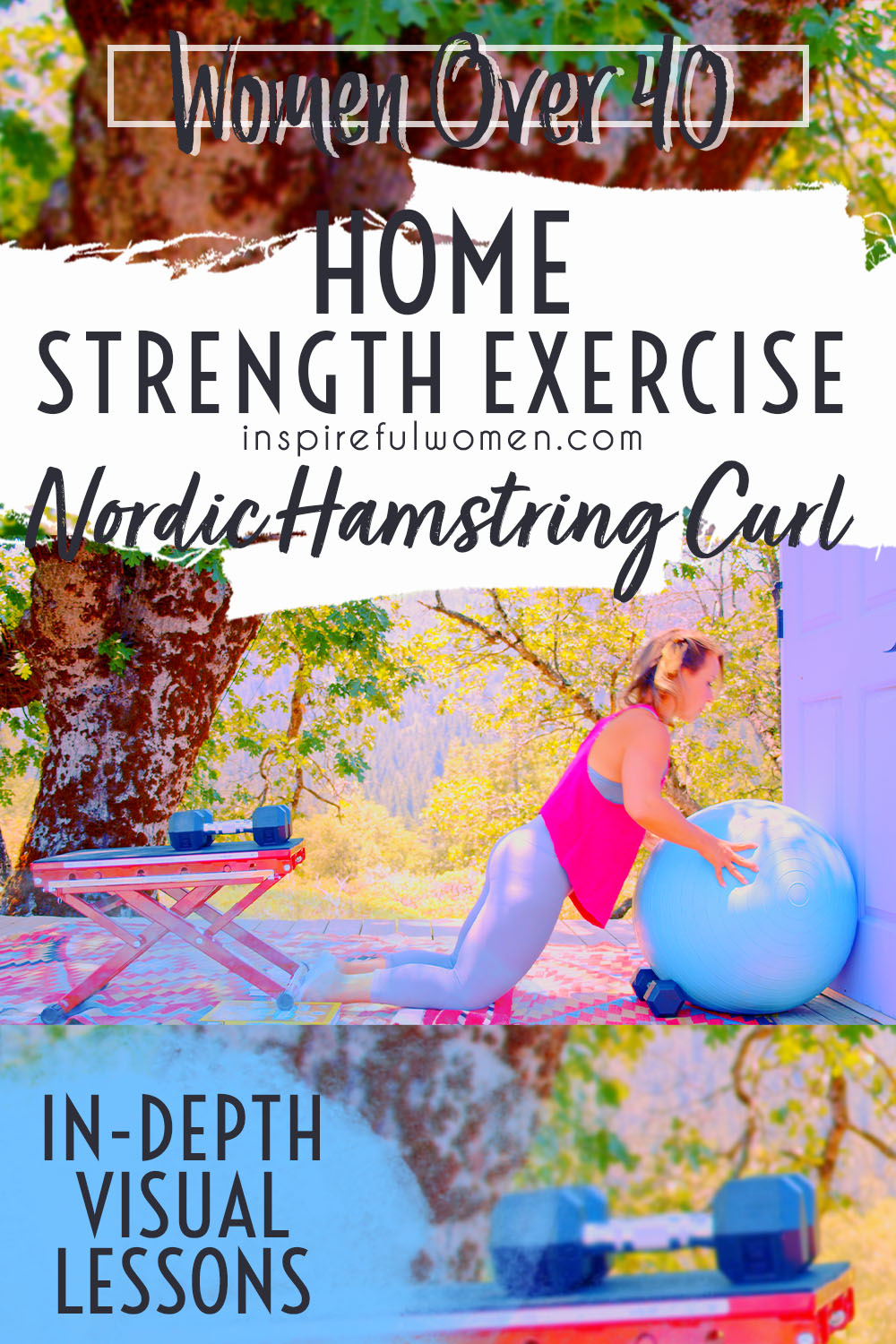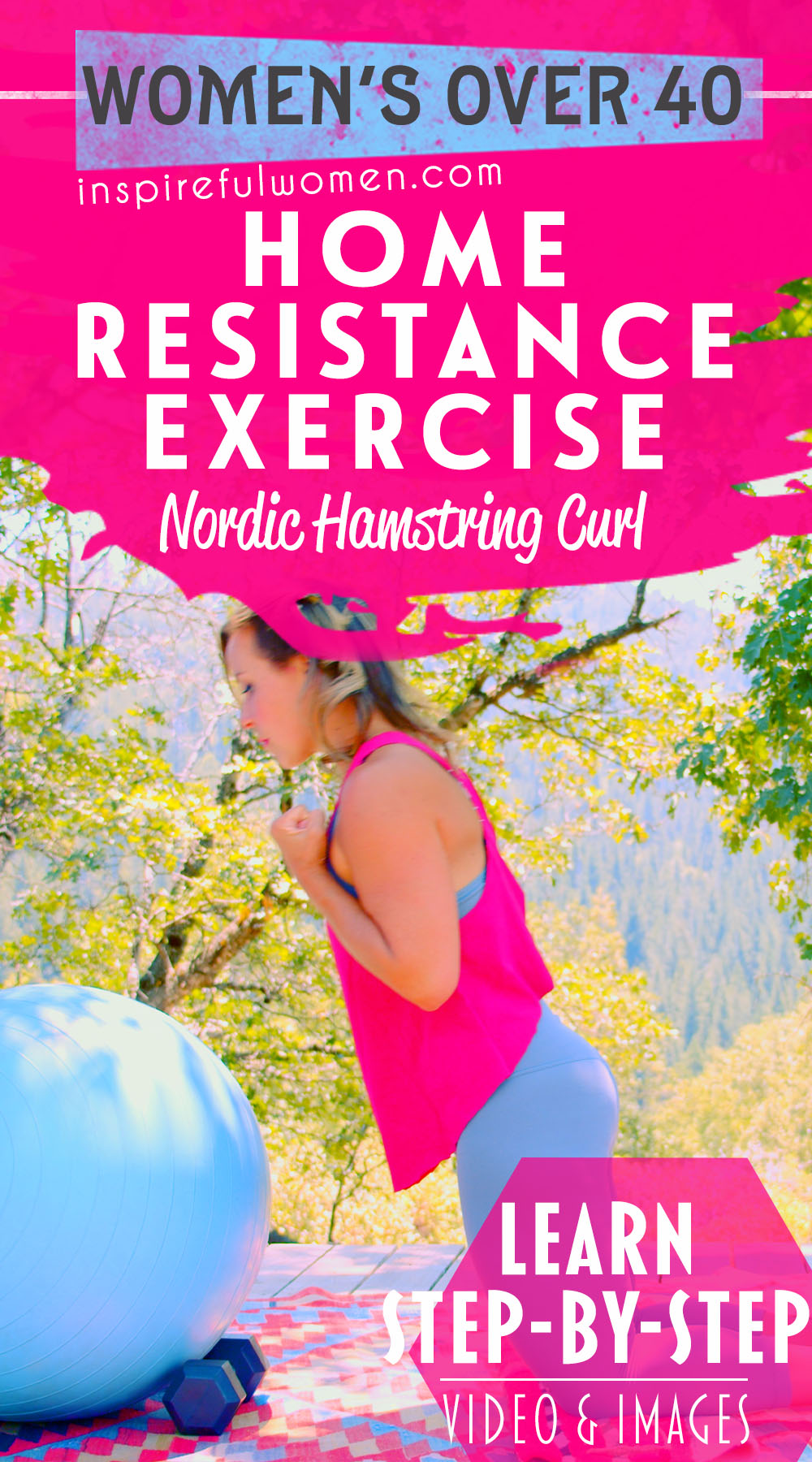Eccentric Nordic Hamstring Curl
How to Do the Beginner Nordic Hamstring Curl at Home - Eccentric Fall on Ball | In-Depth Guide [VISUAL LEARNERS] Beginner
Proper Form, Common Mistakes, Variations + Easier & Harder | Home Strength Training
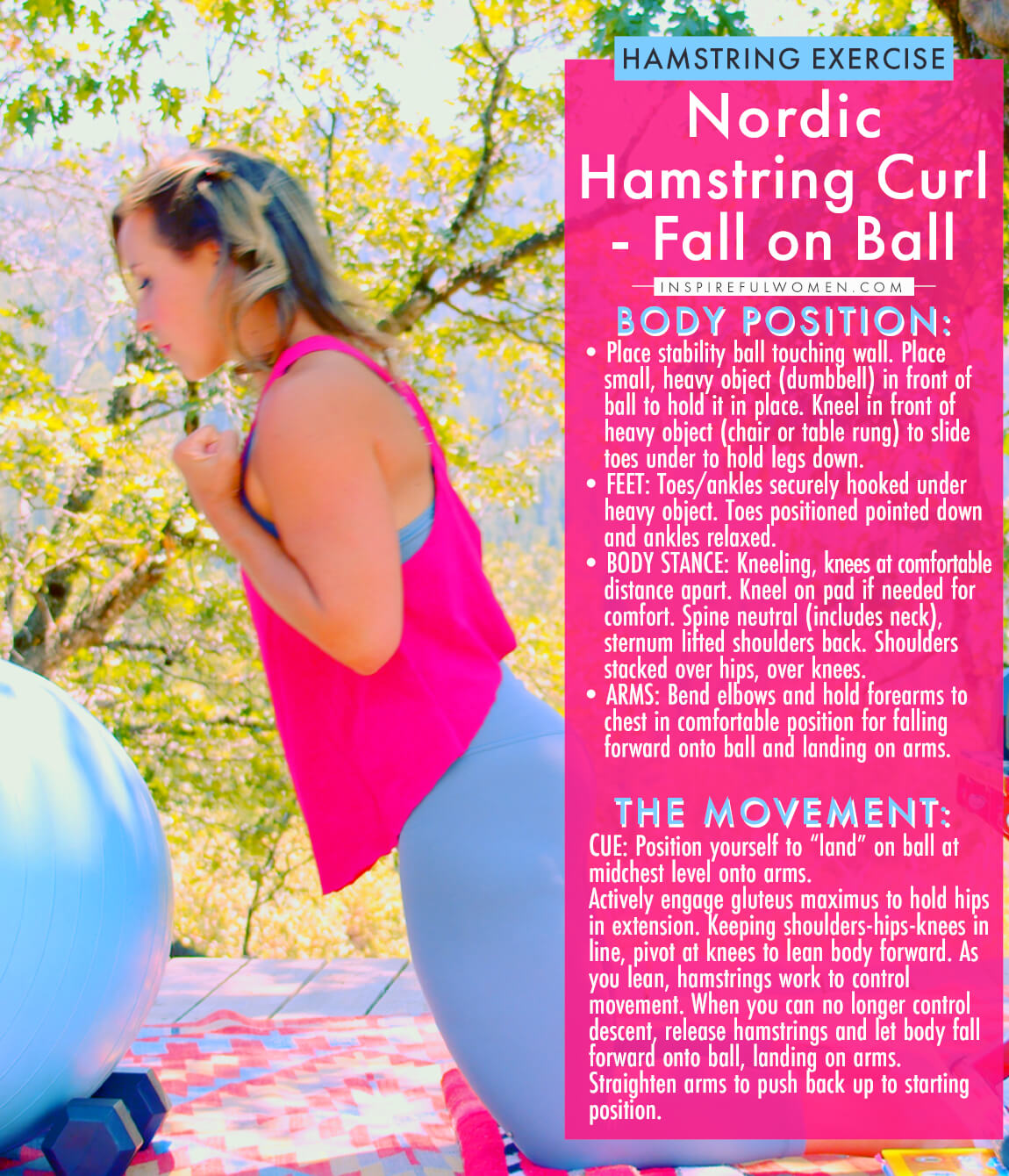
WHAT DO YOU WANT TO SEE?
QUICK DEMO
QUICK DEMO
MUSCLES THIS WORKS
MUSCLES
MAIN MUSCLES WORKED IN the Eccentric Nordic Hamstring Curl
HamstringS
OTHER MUSCLES WORKED:
- Gluteus maximus
- Gastrocnemius
- Core
WHAT WE'RE DOING TODAY
WHAT & WHY
BENEFITS OF TRAINING THE Hamstring
WHAT
WHAT WE'RE DOING TODAY
Other names for this exercise: Bodyweight Hamstring Eccentrics, Bodyweight Hamstring Curl, Fall-on-the-Ball Nordic
ALL WE'RE DOING:
This exercise is basically a controlled fall. But don't worry I'm not going to ask you do it backwards into your enemies arms. 😉
Eccentric Nordics focuses on training the hamstrings, specifically working the hamstrings to slow down the movement of the body - basically putting on the brakes. This is excellent for improving hamstring strength and is one of the few home exercises that is really truly HARD enough on the hamstring muscles to build muscle.
And you don't even have to go to Norway to ot his exercise. It's done kneeling on the floor in the comfort of your own home, with the feet secured under a heavy object, one that will support the weight of the body.
NOTE: I found a GREAT little item for securing your feet that secures under a door that's made just for doing this movement at home - check that out here. I have this little doo-hicky & it works great. It is not shown in my video demo because it didn't exist at that time, but this is really the best set up for this.
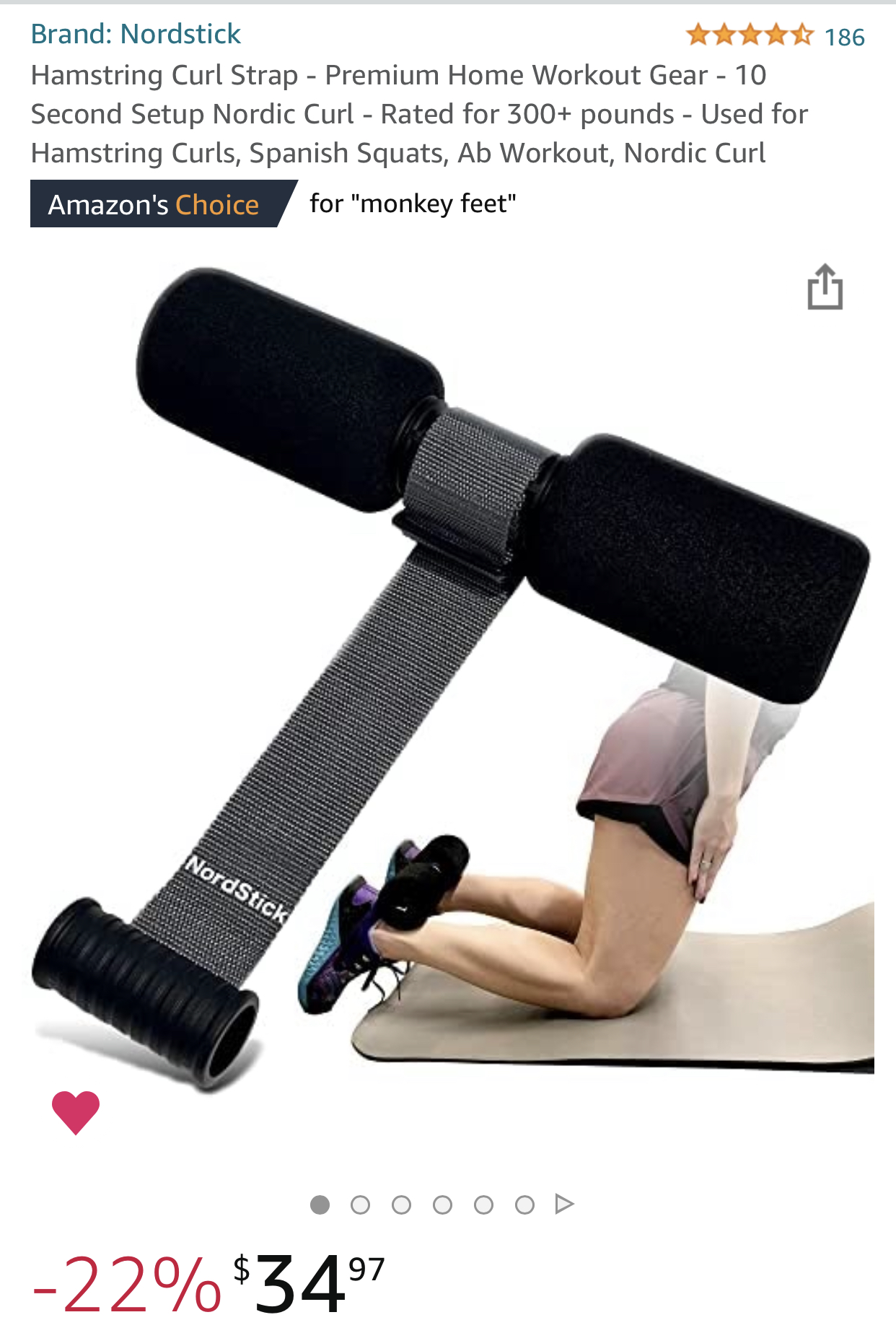
The Nordic exercise uses bodyweight as resistance. As soon as you lean the body forward gravity takes over to pull you down. And don't think that means it's easy! It's wayyyyy hard. So much so that you will likely never be able to do the concentric portion of this exercise. For most of us (unless you're a hulking dude with legs the size of large tree trunks which if you are, I think you are in the wrong place) doing just the lowering portion of the exercise unassisted (the eccentric part) is all we'll ever be doing. I've been doing these for a year and a half and that's where I'm at. This is normal & fine! Doing just the lowering is a GREAT strength builder for our hammies.
The hamstrings, gluteus maximus, and large calf muscle will be working together to control the body as it is pulled down. When you reach the point where the hamstrings are not strong enough to hold your bodyweight, you return to the starting position for the next rep.
The Nordic Hamstring curl works the hamstring eccentrically - this means that the muscle is getting longer as it supports and controls the movement of the weight of your body. This type of exercise is really good for increasing your strength and the health of the muscle. But be careful starting out because this type of exercise can also be very taxing to the muscle. Start slowly, and progress slowly. The exercise shouldn’t feel too challenging at first.
WHY BOTHER DOING IT?
WHY
WHY DO WE EVEN CARE?
BEST INJURY PREVENTION FOR HAMSTRINGS - WHY YOU SHOULD CARE ABOUT THIS
I have to say something. There was a time when the idea of doing an exercise for the purpose of "injury prevention" was like, the least motivating reason to do it that I could possibly think of. You might as well have told me that if I run a marathon I'll get to have some broccoli at the end. Yeah....you know what, that's okay, I'm good. That's because in my twenties to mid-thirties, in general "injury" just wasn't something that ever really happened to me. I could do most things and my body would just, handle it.
But you know what? That has changed. As I hit my late thirties and then pass the forty threshhold, my body seems to have transitioned. I get injured much more easily now.
Tendons are one of the things that seem to "start to go" lol. And rehabilitating an injured tendon takes months to heal. I would know because I've been through this process now with multiple tendons. And it's a PAIN in the butt. You think you're busy now? Try adding in a half hour of special exercises just for that one injured body part, every single day, in some cases twice a day, for months, until you are back to a normal level again.
So......the idea of injury prevention is suddenly quite interesting and desirable to me. Kind of like being told if I run a marathon I'll get a carton of ice-cream or all the lululemon leggings I want in every color I want afterwards. Insert whatever you would find pleasing. I'm so there!
You will literally save SO much time and grief by training in such a way over 40 that helps with injury prevention, rather than letting the changes going on in our bodies catch us off gaurd.
BALANCE OUT QUAD STRENGTH
Many of the exercises that we do target the large muscle on the front of the thigh - the quadriceps. Working the muscle on the back of the thigh is often overlooked, probably because it is a harder muscle to exercise without fancy equipment like weight machines. Muscles work in pairs - the muscles on the opposite sides of the joint work together to control the movement and also stabilize the joint. Strengthening the quadriceps without strengthening the hamstring muscle causes an imbalance. The weaker hamstring will not be able to keep up with the stronger quadriceps. This can cause you problems down the road.
PROTECT THE KNEE JOINT
The hamstrings and quadriceps work together to stabilize and protect the knee joint from impact in order to prevent damage to the cartilage and soft tissues. One of the main jobs of the hamstrings is to work with the quadriceps to control the movement of the knee joint as it bends and straightens during daily activities like walking, running and jumping. Instability (or excessive movement) in the knee joint can result in osteoarthritis.
The quadriceps are the large power muscles on the front of the thigh that act to straighten the knee. The hamstrings must work in a lengthened (eccentrically) position to slow down or decelerate the knee as it straightens (extension) to stop the movement and to prevent knee injury. The Nordic hamstring curl trains the muscle to slow down movement as gravity pulls the body down, straightening the knee. This type of exercise is known as eccentric training. Eccentric training is used to build strength - not only does this mean the muscle will be stronger, but it also means that the strength of the muscle fibers is greater - so the muscle is less likely to be injured. Eccentric training is also thought to increase metabolism and promote healing. Training a muscle eccentrically requires that you “overload” the muscle. This means that the muscle is not able to hold the load. The Nordic hamstring curl is a good example of eccentric training. The hamstring works to try to hold the force of gravity pulling down on the body (as it gets closer to horizontal) gets to be too much for the muscle so your body eventually falls forward.
PREVENT ONE OF THE MOST COMMON MUSCLE/TENDON INJURIES
Most muscle injuries happen when the muscle is actively lengthening (during eccentric contractions), the muscle contraction pulls the muscle fibers apart and tears it. This is common during running and cutting, the stronger quadriceps pull the leg forward and the hamstrings (which are being stretched) need to slow the movement of the leg down but it is not strong enough so it tears apart. Our body responds to how it is trained. For example, if you are going to run a marathon the best way to train is to run for long periods of time, not short distances. If you want to prevent stretch injuries to the muscle you would strengthen the muscle as it is lengthening. Eccentric exercises strengthen the muscles as they are lengthening and also teach the muscles how to decelerate movement.
When the muscle is lengthened and the fibers are pulled apart it causes a lot of damage to the muscle tissue. The result of this can be quite a bit of muscle soreness after the exercise. This can happen after long days of downhill hiking or skiing. Strengthening the muscle with eccentric training improves the muscles ability to work for longer periods of time with less muscle damage. So, if it’s autumn and you’re hoping to go skiing or snowboarding this winter, now would be a good time to add these in a few times a week to prep yourself!
It is also common to have knee joint pain after hiking downhill or skiing, this is due to the fact that the quadriceps and hamstrings act together to stabilize and absorb the impact on the knees. When both muscles are not strong enough they are not able to protect the knee from injury. So it’s winter or spring and you want to hike a mountain, and you know you also have to hike back down it and it’s steep, adding these in a couple times a week can really help!
Eccentric contractions promote cell metabolism. Cell metabolism is The ability of the cell to use energy to perform its functions - for muscles this includes using oxygen to contract, repair, rebuild, remove wastes. Apparently eccentrics improve the tendon cells (tenocyte) and muscle cells (fiber or myocyte) to perform its functions.
How they do this is not completely understood, but there is plenty of research that supports improved tendon healing and muscle growth after regular eccentric training.
BONUS: CORE EXERCISE
Another great benefit of this exercise is that it works the core muscles. All of the core muscles, and especially the back extensors must work to hold the spine in neutral. As you lean the body forward the tendency is to “break” at the waist. You must keep the torso in a line, pivoting at the knees. This requires a lot of core strength.
GET BACK THE SPRING IN YOUR STEP!
The gastrocnemius is one of the calf muscles. This muscle works with the soleus muscle to point the toe down. This is the movement needed for a normal gait. When the foot points down, it propels the body forward. With age, our calf muscles tend to get weaker and we lose the spring in our step. The gastrocnemius crosses the knee joint and helps the hamstring to bend the knee. The Nordic works the gastrocnemius muscle to help lower the body down and to pull it back up again.
EVERYDAY LIFE
EVERYDAY LIFE &
MUSCLE FUNCTION
HOW WE USE OUR Hamstrings IN EVERYDAY LIFE
1. BEND (FLEXES) THE KNEE
- Pushing the elevated leg rest of a recliner down
- Scooting a chair into the table
- Pulling your foot back to tie your shoe
- Bending your knee to get into position to kick a ball
2. PULLS OUR LEG BACK (EXTENDS OUR HIP), ALL HAMSTRINGS EXCEPT FOR THE SHORT HEAD OF THE BICEPS FEMORIS - IT DOES NOT CROSS THE HIP JOINT
- Running up hills
- Walking up the stairs
- Getting up from sitting
- Getting up from the floor
- Walking up an incline- especially uphill
3. WORKS WITH QUADRICEPS TO CONTROL LEG MOVEMENT
- Walking
- Running
- Jumping
- Kicking
- Squatting
4. WORKS WITH OUR QUADRICEPS TO KEEP OUR KNEE & HIP STABLE TO PROTECT JOINTS FROM DAMAGE DURING STANDING & MOVING
- Standing
- Balancing
- Standing on a ladder with the weight on one leg to reach for painting/window washing
- Walking on ice or uneven surfaces
- Going up and down the stairs
STARTING POINTERS
Starting Pointers
This version of the Nordic Hamstring Curl is the eccentric part of the exercise only (just the lowering portion). This means that the hamstrings will be working to help control the movement of the body as it leans over towards the ball, but you will use your arms to push yourself back up again.
This exercise has a bit of a strange set up but its' really worth spending the time to get your personal setup in place. You only have to figure it out once, then you'll be able to use that setup over and over for years. There's a few ways to do it.
You will need a large stability ball that you can “fall” on to. That goes for all setups.
1. Setup Option One:
Use the door anchor made for this purpose to stick your feet under.
Get a holder for your yoga ball - this will keep the ball in place in front of the door where you are positioned so that it doesn't just roll away (if I know you well, you don't want to do a face plant on your floor)
You will put the door anchor under the door and position the yoga ball holder and ball in front of you. If the floor is hard, put a small knee yoga mat under your knees.
2. Setup Option Two:
Stick your feet under a couch or bed that's an inch or two off the ground as your anchor. No purchase necessary.
If you have a wall the right distance in front of you from this position, you can simply position the stability ball against that wall area and secure it with a dumbbell in front of it.
If you don't, use the yoga ball holder to hold your ball in place in front of you.
3. Setup Option Three:
This is the least ideal because it's kind of a pain to set up. Use a heavy step up bench designed for working out, and place a book or two under the front feet. Weight the top of the bench down with heavy dumbbells is need be to make it heavy enough to hold it's own against your weight. Your feet will go under the space at the front of the bench created by the bottom of the bench being on the books.
Position the ball in front of you either in a yoga ball holder, or up against a wall secured with a dumbbell in front of it.
-------------------------
Once the setup is complete, the hamstrings work to lower the body down towards the ball/object. As soon as you lean the body forward gravity takes over to pull you down. The hamstrings, gluteus maximus, and large calf muscle will be working together to control the body as it is pulled down. Basically, this is a “controlled fall”.
The setup can take a little time to get right, but once you have established your starting position it is easy to make quick adjustments to the exercise to progress to make it more challenging.
The first time you do this exercise, don’t lean too far over or do too many. Eccentric exercise can make you pretty sore. A good rule of thumb is to try doing more reps or lean a little further over when you are able to do 10 reps with good form and no soreness the next 2 days.
HOW TO FEEL WHAT MUSCLE IS WORKING
How to Feel What Muscle is Working
Sit on the floor with your legs out in front of you. Bend one knee up so that you can put your hand on the back of your thigh without rounding your lower back. Keep the heel of the foot on the floor. Push down with your heel and pull back, as if you wanted to pull the floor towards you. You should feel the hamstring on the back of the leg tighten.
HOW TO DO THE EXERCISE
LOOKS
HOW Eccentric Nordic Hamstring Curls SHAPE OUR BODY
Tones and shapes the muscle on the back of the thigh and the calf. Balances out the large quadriceps on the front of the thigh.
PROPER FORM
PROPER FORM: Eccentric Nordic Hamstring Curl
EQUIPMENT, SETS & REPS
EQUIPMENT
See the "starting pointers" section above this for a more detailed explanation of the setup options.
Something heavy to hook toes or ankles under or someone to hold your ankles down (couch, bed, or this special doo-hicky that goes under the door).
Pad for under knees/lower leg.
Stability ball, dumbbell or heavy object to place in front of the ball, open wall to put the ball against.
SUGGESTED STARTING WEIGHT FOR WOMEN:
Limit how far you will actively lower the body. Make sure you are developing the ability to control the descent- don’t just fall onto the ball.
SETS & REPS:
Only to fatigue/failure. This is a tough exercise, once your form has failed, rest and then try a few more. I would start with only 4-5 reps, just 1 set. After a couple workouts of this, do a 2nd set of 4-5 reps. Then slowly build to 6,7 up to 10 reps. Add a 3rd set eventually.
PACE:
Very slow descent to the ball.
BODY POSITION
BODY POSITION FOR THE Eccentric Nordic Hamstring Curl
Get your initial position based on the "starting pointers" options for setup first.
FEET: Toes/ankles hooked under a heavy object to hold them securely. Best to have your toes positioned pointed down and to have your ankles relaxed - not dorsiflexed actively (held in a toes-up position). This will allow your calf (gastrocnemius) muscle to help.
BODY STANCE: Tall kneeling, hips are flat (not creased), knees at a comfortable distance apart - hip-width or slightly more narrow. You can kneel on a pad if it is more comfortable. Shoulders stacked right over your hips, over knees. Shoulders back, sternum lifted. Core muscles are engaged to stabilize your spine in a neutral position. Neck neutral and relaxed.
ARM: Crossed at your chest - you will be falling onto the ball and landing on your crossed arms. Or if it is more comfortable, bend the elbows and hold the forearms to your chest with your hands just inside of your shoulders (on your chest).
HOW TO DO
HOW TO DO Eccentric Nordic Hamstring Curls
CUE: Keep the shoulders stacked over the hips with the core engaged as you lean the body forward. Focus on the hamstrings doing the work to slow down the pull of gravity. You may need to adjust the setup once you start doing the exercise - you want to “land” on the ball at midchest level onto your crossed arms
Actively engage your gluteus maximus muscle to hold your hips in extension (meaning don't let your hips start creasing as you lower your body. Keep the hips flat & glutes active).
Slowly begin to lean your body forward pivoting at your knees.
Your knees will gradually straighten, using your hamstrings to slow down the increasing pull from gravity.
As you lean you will reach a point where you feel like you can no longer control the descent. At that point, release your hamstrings and let your body fall forward onto the ball, landing on your crossed arms.
Straighten your arms and use them to push yourself back up to the starting position.
HOW TO SAFELY GET OUT OF THE EXERCISE
From tall kneeling, put one leg forward in a lunge position and push to standing.
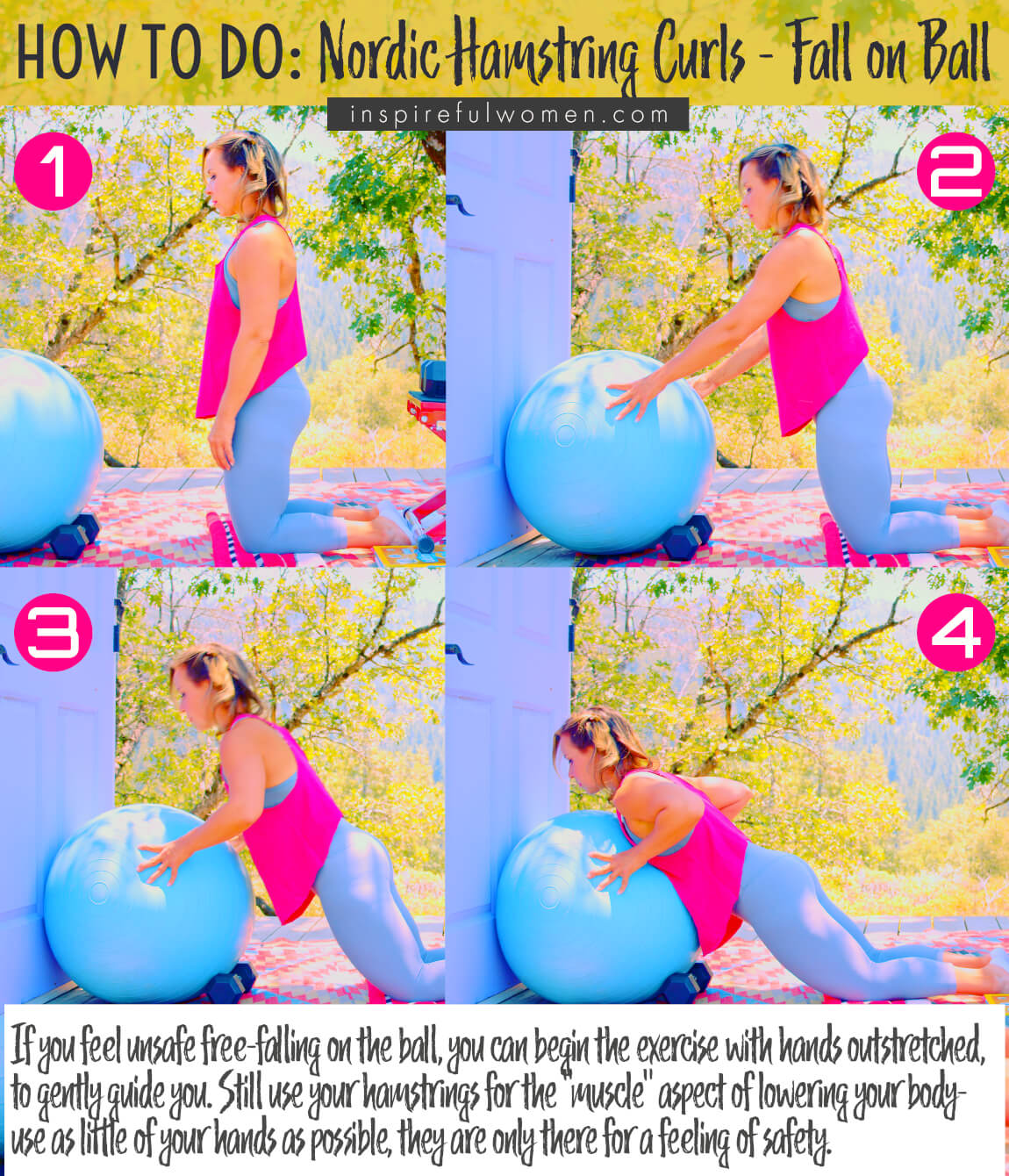
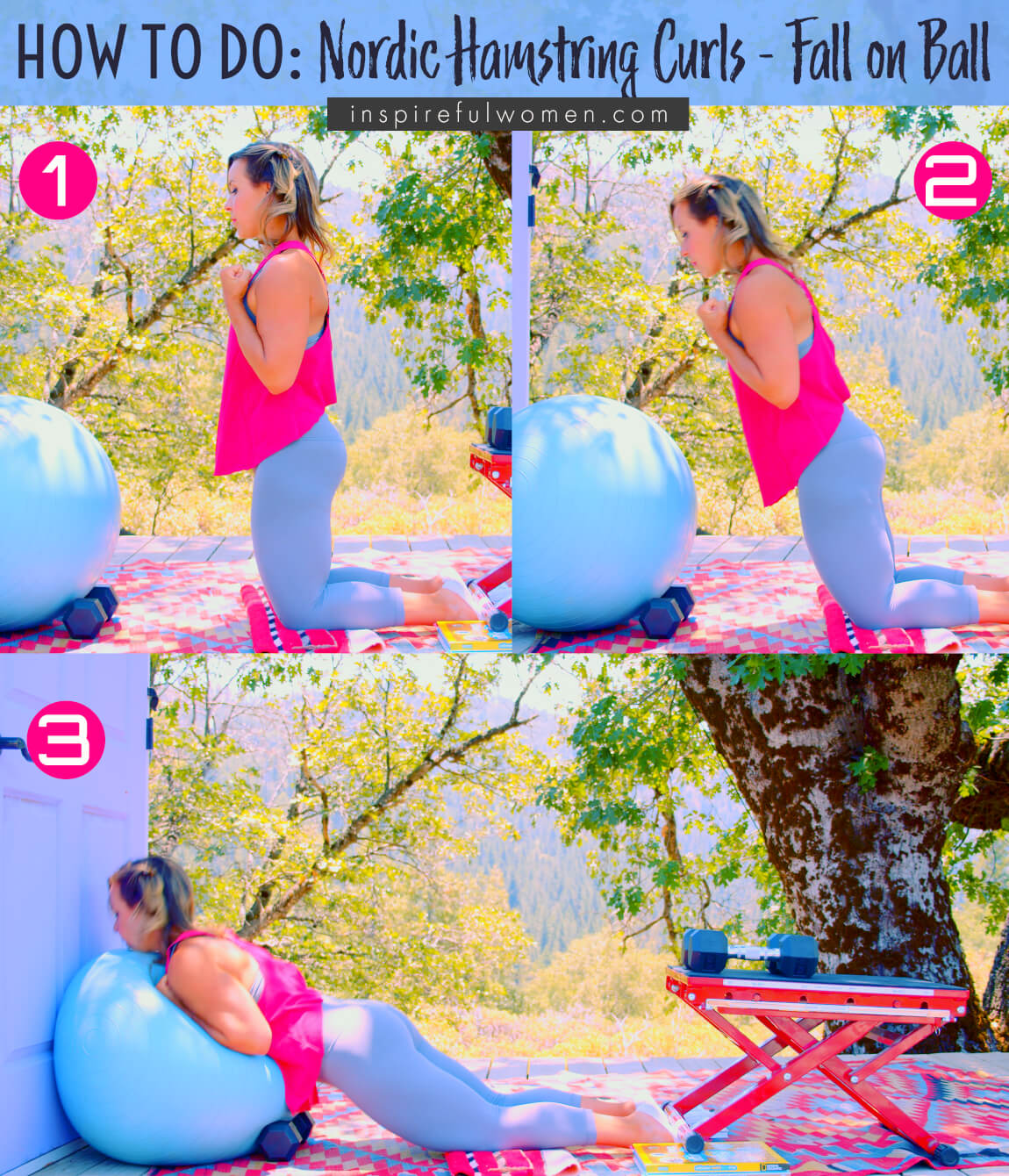
COMMON MISTAKES
COMMON MISTAKES
WHAT TO AVOID WITH THE Eccentric Nordic Hamstring Curl
KEY TIP:
Guess what? Good news! Many avoids are the same for most movements. Once you learn the basics, there's really only a few extra avoids for each individual movement.
1. Avoid Breaking At Hips
AVOID: Avoid breaking at the hips (hip hinging). When you begin leaning forward, if you don’t use your glutes and hamstrings to keep the hips in extension you will fold forward at the hips.
WHY NOT?
- This defeats the goal of the exercise by decreasing the activation of those muscles.
WHAT TO DO:
- Actively engage the gluteus maximus muscle before you begin to lean forward (pivoting at the knees) and keep them engaged.
- Keep the front of the hips flat - no crease.
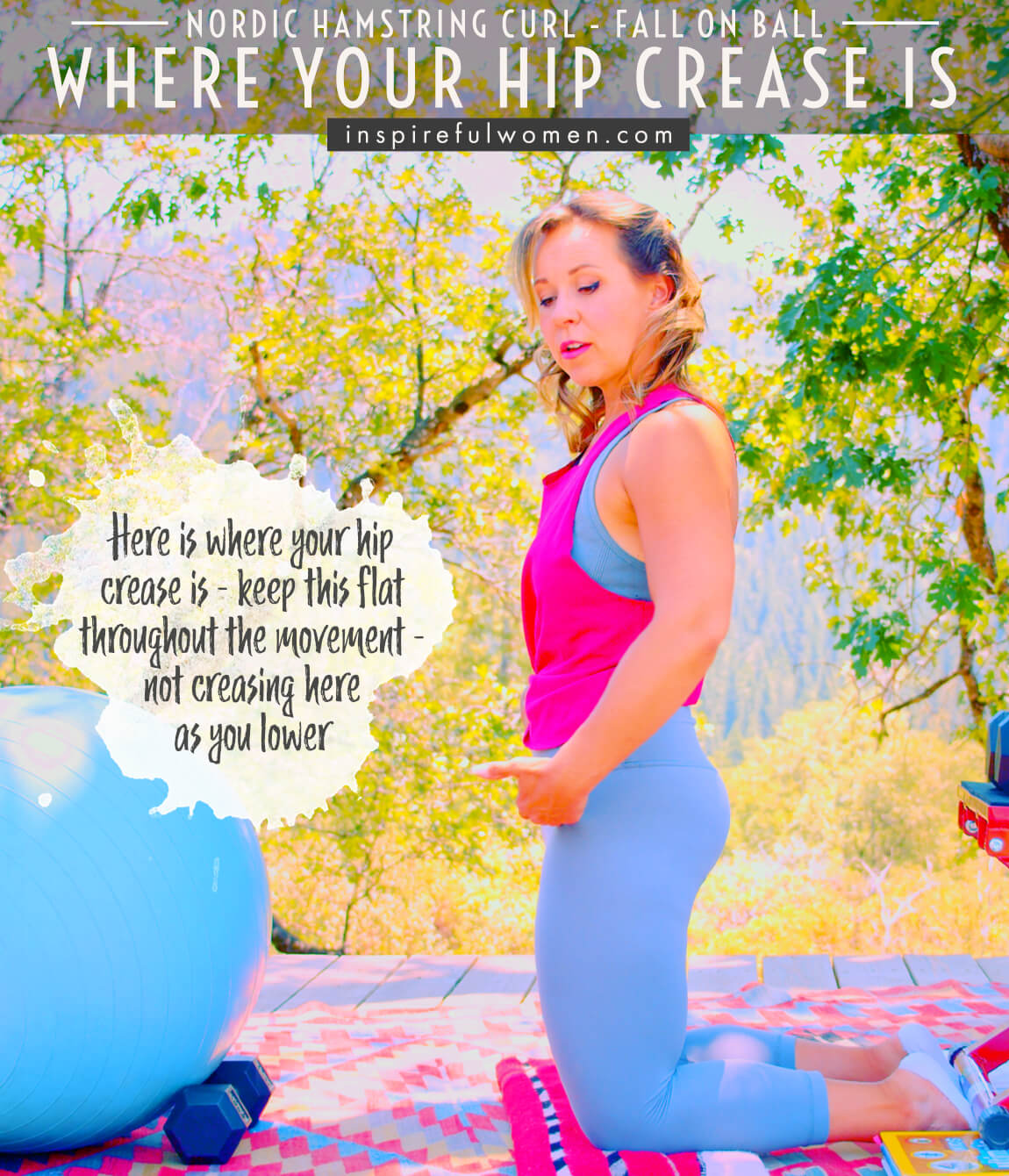

2. Avoid breaking at the waist
AVOID: Avoid breaking at the waist. This is a common error - bending the waist as the body leans forward.
WHY NOT?
- This will decrease the range of motion at the knee joint.
- Will decrease the muscle activity of the hamstrings and the core.
WHAT TO DO:
- Keep your shoulders stacked over your hips, sternum lifted, and pivot from the knees.
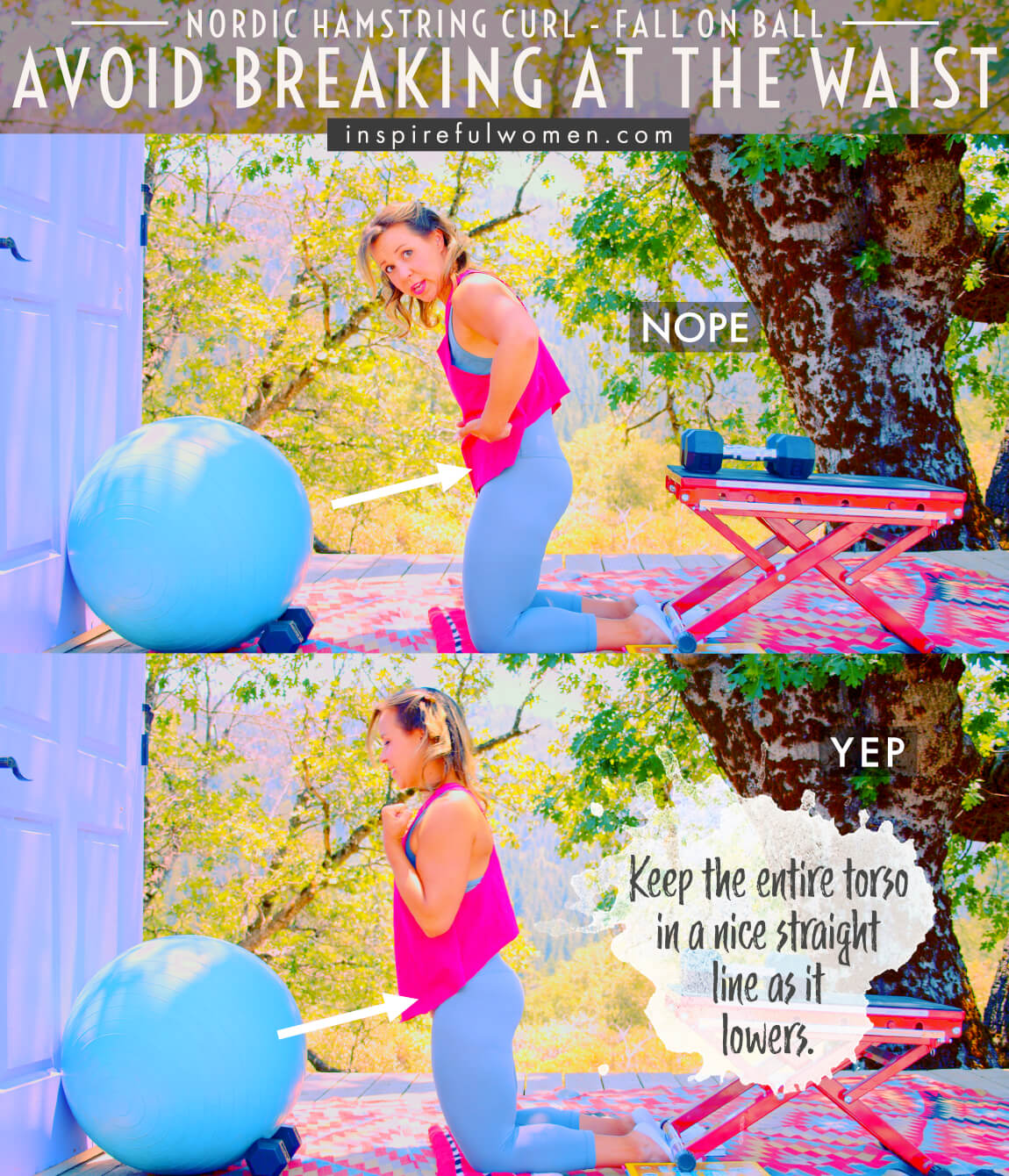
3. Avoid Doing Too many reps
AVOID: Avoid doing too many reps. This is common when first starting an exercise.
WHY NOT?
- Eccentric training is tough on the muscles and can make you really sore.
- It is always better to start with what you feel is an easy set and see how you feel later.
WHAT TO DO:
- Progress the exercises slowly.

MAKE IT HARDER
HARDER
MAKING THE Eccentric Nordic Ham Curl MORE CHALLENGING
BEGIN TO ADD CONCENTRICS
Add Concentrics to Nordic Curl
Once you have fallen onto the ball, place your hands on the ball. Use your hamstrings and calf muscles to bend the knees as you push up from the ball with your hands, bringing yourself upright again. As you get stronger use your hands less and less to help you move back to upright. THIS IS VERY HARD, JUST FYI.
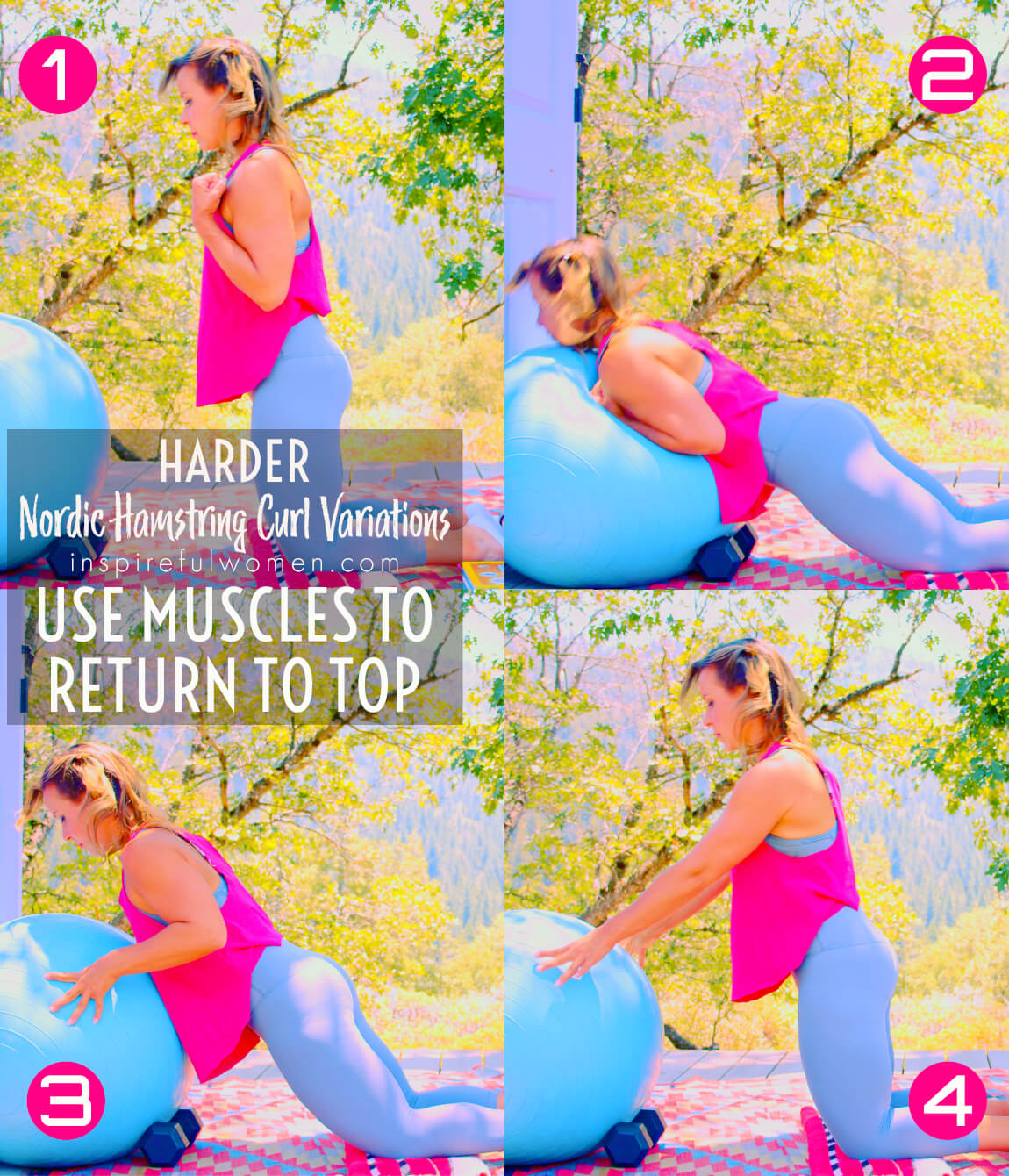
MAKE IT EASIER
EASIER
MAKE THE Eccentric Nordic Hamstring Curl MORE DOABLE
HANDS ON BALL
Hand Supported Eccentric Nordic Hamstring Curl
This is a good option for those that have difficulty being able to relax and “fall” onto the ball, or if you don’t have a set up that allows you to put the ball against a wall and hold it stable. Place the ball in front of you. As you lean forward, put your hands just in contact with the ball. Once you feel the need to put weight through your hands, use your hands or your hamstrings (with assistance as needed from your arms) to pull yourself back up to tall kneeling.
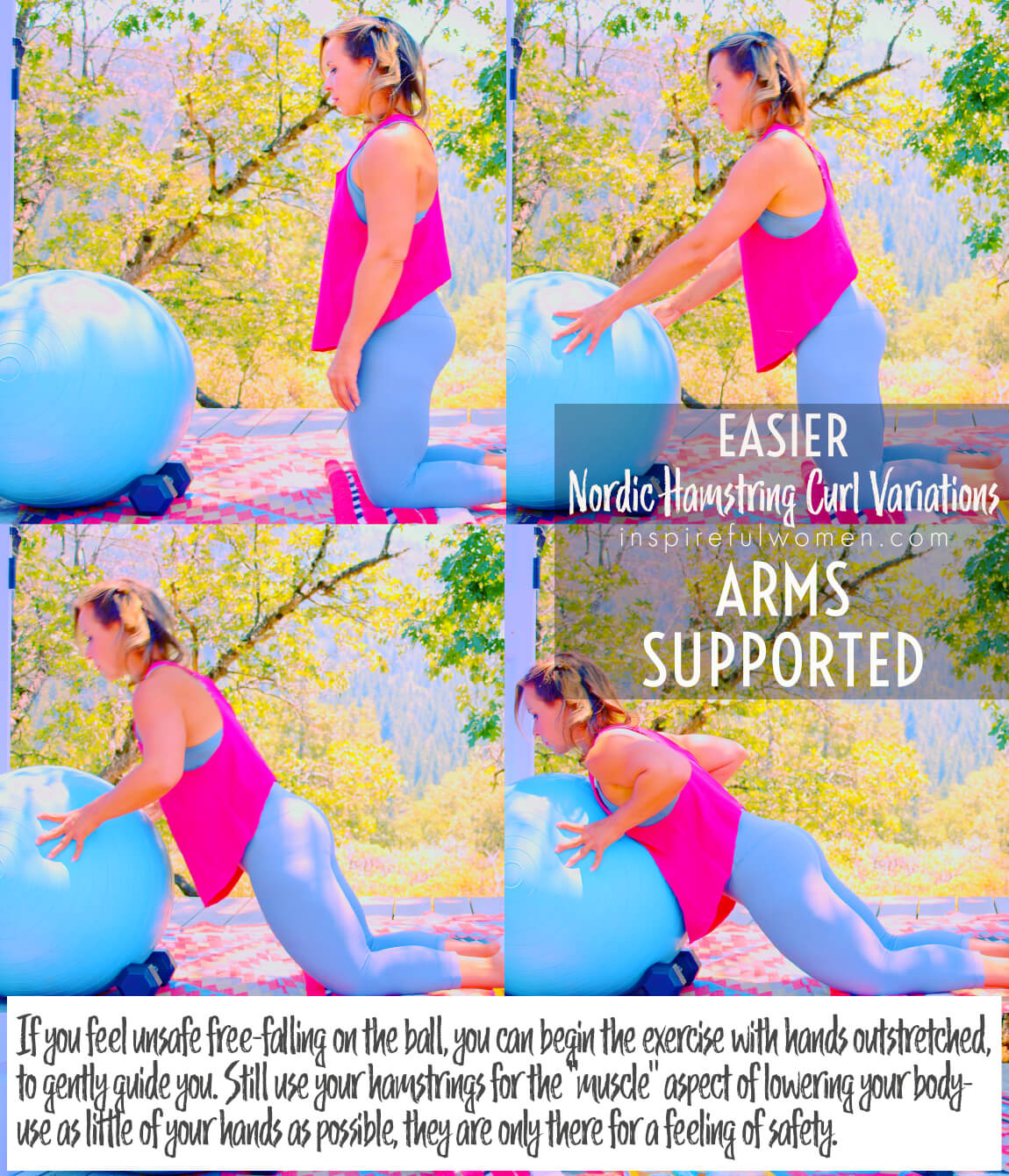
SCIENCY STUFF
SCIENCY STUFF
SPIFFILICIOUS FACTS ABOUT MUSCLES & MOVES
Hamstring strengthening helps to correct quad dominance: It is essential to train the hamstrings eccentrically in order for them to be able to decelerate the action of the strong quadriceps. This is especially important with individuals who have had anterior cruciate ligament injuries or meniscus tears.
Strong hamstrings are needed to balance the strength of the stronger quadriceps muscles. The hamstrings strength should be at least 75% that of the quadriceps.
Hamstrings are a group of muscles on the back of the thighs. The muscles in the group are: the biceps femoris on the lateral part of the femur, the semitendinosus in the middle, and the semimembranosus on the medial surface of the femur. Together the muscles act to extend the knee and the hip. The short head of the biceps femoris is the only portion of the hamstring that does not cross the hip joint - it only crosses the knee.
ALLLL MUSCLES & WHEN
ALL MUSCLES WORKING & WHEN DURING THE Eccentric Nordic Hamstring Curl
The core muscles will be working to hold the pelvis and back in a neutral and stable position. The hamstring is working with the gluteus maximus to prevent the hips from flexing.
As the knees extend the hamstring and gastrocnemius lengthens, working eccentrically to decelerate the weight of the body and control the “fall”.
PIN IT FOR LATER!
